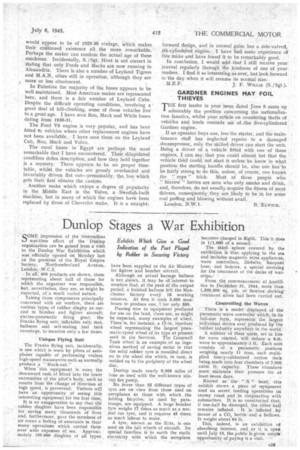Dunlop Stages a War Exhibition
Page 25

If you've noticed an error in this article please click here to report it so we can fix it.
Exhibits Which Give a Good Indication of the Part Played by Rubber in Securing Victory
COME impression of the tremendous
war-time effort of the Dunlop organization can be gained from a visit to the Dunlop War Exhibition which was officially opened on Monday last on the premises of the Royal Empire Society, Northumberland Avenue, London, W.C.2.
In all, 400 products are shown, these representing about half of those for which the organizer was responsible, but, nevertheless, they are, as might be expected, of a much varied nature.
Taking those components principally concerned with air warfare, there are various types of rubber dinghy as carried in bomber and fighter aircraft; eiectro-pneumatic firing gear; the Franks flying suit; inflatable suit; met. balloons and self-sealing fuel tank coverings, to mention only a few items.
Unique Flying Suit
The Franks flying suits incidentally, is one which is worn by pilots of aeroplanes capable of performing violent high-speed manceuvres such as normally produce a " black-out," When this equipment is worn the downward rush of blood into the lower extremities of the pilot's body, such as results from the change of direction at 'high speed, is prevented. Visitors will have 'an opportunity of seeing this interesting equipment for the first time.
It is no exaggeration to say that the rubber dinghies have been responsible for saving manythousands of lives and, furthermore, gave the members of air crews a feeling of assurance in their many operations which carried them over wide expanses of sea. Approximately 100,000 dinghies of all types have been supplied to the Air Ministry for fighter .and bomber aircraft.
Although an actual "barrage balloon is not shown, it may be orinterest to mention that, at the peak of the output period, a finished balloon left the Manchester factory every 18 working minutes. At first it took 3,500 manhours to produce one, '1 .ter only 500.
Passing now to equip/lent produced for use on the land, there are, as might be expected, many examples. of wheel. There is, for instance, a 17-in. howitzer wheel representing the largest pneumatic-tyred wheel of its type at present used in the Services, The Cromwell Tank wheel is an example. of an ingenious method of saving metal in that the solid rubber tyre is moulded direct on to the wheel rim which, in turn, is welded on to the periphery of the wheel disc.
Dunlop 'made nearly 9,000 miles of hose as used with the well-known stirrup fire pump.
No fewer than 25 different types of tyre are on view from those used on aeroplanes to those with which the folding bicycles, as used by 'paratroops, are equipped. A large bomber tyre weighs 17 times as much as ,a norMal car tyre, and it requires 45 times as much labour to make.
A tyre, known as the Ecta, is one used on the tail wheels of aircraft. Its speCial function is to earth the static electricity with which the aeroplane
becomes charged in flight. This it does in 1/1,000 of a second. .
-The third sphere covered by the exhibition is that applying to the sea and includes magnetic mine appliances, wave controllers, lifebelts, buoyant hose, and Semtex, a special covering for the treatment of the decks of warships",:r From the commencement of hostilities to December 31, 1944, more than 1,500,000 sq, yds. , of Semtex decking treatment alone had been carried out.
Controlling the Waves
. There is a model diSplayed of the pneumatic' w.nve controller which, in its full-size form, represents the largest individual device ever produced by the 'rubber industry anywhere in the world. A number of these 'units, set in line • for wave control, will reduce a 6-.ft., wave to approximately -1 ft. Each unit consists of a pneumatic pontoon weighing nearly 11 tons, each multiplied heavy-rubberized cotton deck being made into four chambers of 7,000 cubic it.' capacity. These chambers must • maintain their pressure for at least seven days.
Knowai as* the " X " boat, this exhibit shows a piece of equipment used on secret landing operations on enemy coast and in conjunction with Submarines. It is so constructed that, if one-half be damaged, the other half remains inflated. It is inflated by means of a CO2 bottle and a bellows. It weighs about 64 lb.
This, indeed, is an exhibition of absorbing interest, and as it is open until July 13, the public is given ample opportunity of paying it a visit.




















































